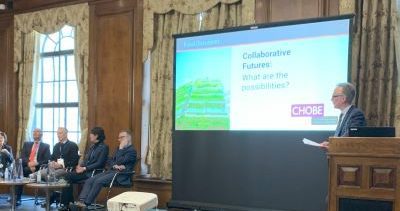UCEM’s Built Environment Skills Summit report demands the UK rises to the challenge
Posted on: 31 January, 2018
UCEM’s Built Environment Skills Summit report demands the UK rises to the challenge and overcomes mounting skills crisis
- UK is facing one of its greatest ever challenges – an acute shortage of the skills needed to meet construction demand
- Sector leaders say, “It’s time for change”
- More collaborative approach is required between industry, Government and education
UCEM has today published a report examining the Built Environment sector’s skills crisis, which urges action to reverse the trend.
The report is the result of UCEM’s inaugural Built Environment Skills Summit and subsequent research. Key stakeholders from across the sector – including representatives from the Royal Institution of Charted Surveyors (RICS), Chartered Institute of Building (CIOB), Construction Industry Training Board (CITB), Building Research Establishment (BRE) and the Cabinet Office – came together to discuss the current skills challenges at the Summit and devised both short- and long-term solutions.
It’s becoming ever more apparent that the current levels of training and education for all Built Environment disciplines in the UK are inadequate in meeting the growing needs of the sector. Talent supply is both insufficient and inadequate. The UK must hire more than 400,000 construction workers every year for the next five years to meet demand.
The report captures the salient points from the presentations, discussions and workshops held at the Summit, and presents a summary of the current challenges, desired outcomes and a declaration of immediate actions on behalf of the attendees. It was found that the main issues were the lack of joined-up thinking across all stakeholders, the lack of an overarching leadership body for skills, and the urgent need for both current and future skills.
Suggested next steps include:
- An integrated holistic picture of the Built Environment: to include what the sector is about, how it operates, and what its aims and objectives are.
- A longer-term, industry-led, integrated and sustainable vision: to join together policy imperatives over 5, 10 and 30 years, and stabilise demand and supply needs.
- A unified careers and qualifications competence model: to promote a single shop window into Built Environment professions and provide pathways to lifelong career options.
- An interface communications group: to allow for more integrated, joined-up conversation across all Built Environment disciplines and coherent responses to government policy in a timely manner.
- An ongoing quality mark for skills certification: to provide recognition of ongoing individual competence and a ‘licence to practice’, which evidences the currency and relevance of skills.
- A unified core curriculum across professional bodies, institutions and providers: to provide relevant, high-quality, assured content – aligning with professional requirements and competencies/occupational standards.
UCEM Principal, Ashley Wheaton, said, “There are substantial ongoing challenges with attracting new talent into the required professions at all levels, as well as retaining existing staff. In addition to these issues, the UK has set ambitious targets for infrastructure projects and residential construction growth. In themselves, these factors would present a considerable challenge. However, the situation is further compounded by the lack of cohesion, alignment and collaboration in the skills supply chain for the Built Environment.”
Amanda Clack, Executive Director – Head of Strategic Consulting, CBRE, and immediate Past President RICS commented, “If we’re serious about the skills gap, we must consider how to make the sector more attractive. We need to consider pathways for entry and how we ensure the next generation of professionals have the right skills to make them employable for the future; this includes thinking about digitalisation and innovation. We have to also realise the potential of apprenticeships, through unlocking the levy and funnelling that meaningfully back into our sector. Plus, we need to do more to make the sector more attractive and better understood in schools.”
For further details, please take a look at the full ‘Solutions to the Built Environment Skills Crisis’ report.





